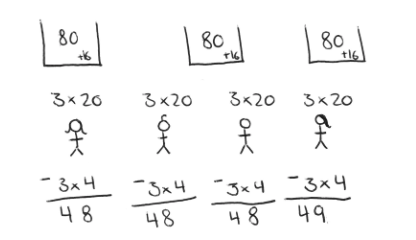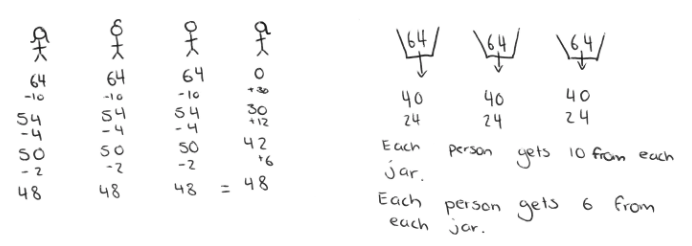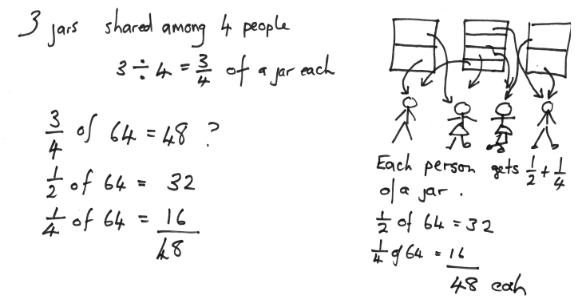Jellybean equal shares
The purpose of this activity is to engage students in equally partitioning a set of objects among four parties.
This activity assumes the students have experience in the following areas:
- Calculating a fraction of a whole number amount, e.g., 3/5 x 40 = 24.
- Solving division problems where the quotient is a fraction, e.g., 5 ÷ 3 = 5/3 or 1 2/3.
The problem is sufficiently open ended to allow the students freedom of choice in their approach. It may be scaffolded with guidance that leads to a solution, and/or the students might be given the opportunity to solve the problem independently.
The example responses at the end of the resource give an indication of the kind of response to expect from students who approach the problem in particular ways.
Four friends share three jars of jellybeans equally. Each jar contains 64 jellybeans.

How many ways can you find that they might do this?
Which way is the most efficient? Explain why.
The following prompts illustrate how this activity can be structured around the phases of the Mathematics Investigation Cycle.
Make sense
Introduce the problem. Allow students time to read it and discuss in pairs or small groups.
- Do I understand the situation and the words? (Students need to understand that equal shares require each person to receive the same number of beans. They also need to accept that the jars can be opened, and beans can be distributed.)
- Does this look/sound like a problem I have worked on before? What operations are usually involved for problems like this? (Students should appreciated that division is the operation that can create equal shares. They might also see that multiplication can be used to find the total number of beans.)
- What will my solution look like? (The solution involves more than finding the equal share. It requires students to find different strategies and to compare those strategies for how they work.)
Plan approach
Discuss ideas about how to solve the problem. Emphasise that, in the planning phase, you want students to say how they would solve the problem, not to actually solve it.
- What do I need to know to get started? Do I have all the information I need?
- How could I show this problem using numbers, pictures, graphs, tables, or materials? (Physical, pictorial, or graphic representations will be helpful to some students while others may go directly to equations with numbers.)
- What strategies can I use to get started?
- Do I expect there to be a pattern? What might the pattern look like?
- What tools (digital or physical) could help my investigation? (The numbers make the problem accessible with mental and paper methods. Some students may benefit from access to calculators.)
Take action
Allow students time to work through their strategy and find a solution to the problem.
- Am I showing my workings in a step-by-step way that others can understand?
- Have I recorded my ideas in a way that helps me to see patterns? (Recording equations is very important for students to see patterns in the operations and recognise that the order of the operations does not matter.)
- Are there any patterns?
- How might I describe the patterns?
- Does my solution/s answer the question? Have I checked that the solution/s meet all the conditions?
- Is there another possible way to solve the problem? Have I tried many ways?
Convince yourself and others
Allow students time to check their answers and then either have them pair share with other groups or ask for volunteers to share their solution with the class.
- What is the solution?
- Is my working clear for someone else to follow?
- How would I convince someone else I am correct?
- Could I have solved the problem in a more efficient way?
- Which tools were useful in solving this problem?
- Which strategies worked well in my investigation?
- Can I think of other problems that are alike this one? How are these problems alike?
Examples of work
Work sample 1
The student uses appropriate calculations to find the share that each friend receives.
Students who are in the early progressions of algebraic thinking favour closure. That means they prefer to know in advance the quantities they are dealing with rather than treat those quantities as an unknown. The least sophisticated strategy is to calculate the total number of jellybeans then divide that total by the number of shares. There are likely to be variations in the methods student use to calculate their answers in this way.
Click on the image to enlarge it. Click again to close.
Students will desire closure may carry out the operations in the opposite order. They might share each jar among the four people then combine the three amounts.
Click on the image to enlarge it. Click again to close.
Other strategies include giving a whole jar to three people then compensating the fourth person from each jar until equal numbers are reached.
Click on the image to enlarge it. Click again to close.
Students might also alter the number of jellybeans in each jar so that the number is easily divisible by four. Then they may compensate to allow for the rounding.
Click on the image to enlarge it. Click again to close.
Work sample 2
The student attempts a variety of approaches to find the equal shares and describes the similar structure in those approaches.
Students who operate without closure tend to be more interested in the process by which answers are obtained than their closure preferred classmates. They will look for diverse ways to solve the problem by procedures. These students may recognise that the same operations are performed in different orders without changing the answer. In the first method (3 x 64) ÷ 4 = 48 was calculated and (64 ÷ 4) x 3 = 48 was calculated in the second method.
Click on the image to enlarge it. Click again to close.
Conceptually focused students are also more likely to apply the quotient theorem, j÷p = j/p where j represents the number of jellybeans and p represents the number of people. Students using this approach find the fraction of a jar that each person gets first without the closure of knowing the total number of jellybeans.




